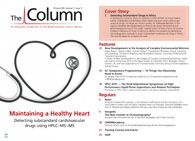Quantification of Celiac Disease Gluten Epitopes
Scientists have published a novel method to detect multiple celiac disease-epitopes in wheat extracts simultaneously using liquid chromatography–multiple reaction monitoring mass spectrometry (LC–MRM–MS).
Scientists have published a novel method in the Journal of Chromatography A to detect multiple celiac disease-epitopes in wheat extracts simultaneously using liquid chromatography–multiple reaction monitoring mass spectrometry (LC–MRM–MS).1
Celiac disease is caused by an immune response in the small intestine from eating gluten proteins. An enzyme-linked immunosorbent assay (ELISA) is the standard testing method for food, but this can be inaccurate and does not differentiate between gluten proteins. Lead author Hetty van den Broeck told The Column: “This newly developed method based on mass spectrometry quantifies specifically celiac disease stimulating epitopes. This is not possible by ELISA, which detects gluten proteins in general by using a monoclonal antibody. Mass spectrometry allows specific detection and quantification of multiple CD-epitopes at the same time. This is necessary because of the complex genome of bread wheat and the many different CD-epitopes to which CD-patients can respond differentially.”
In the current study, gluten extracts were prepared from wheat and extracted prior to LC–MRM–MS analysis. The authors developed the method to detect peptides known to induce the strongest immune response, as well as peptides with amino acid substitutions that make them harmless. The method was able to quantify different peptide isoforms, showing that a modern wheat variety, Toronto, contained the highest level of CD immunogenic peptides.
The team are continuing their work to test and select reduced immunogenic wheat varieties, van den Broeck told The Column. She said: “We are also working on the development of screening body fluids from CD-patients for the presence of these epitopes or other specific peptide biomarkers for CD.”- B.D.
Reference
1. H.C. van den Broeck et al., J. Chromatogr. A1391, 60–71 (2015).

New TRC Facility Accelerates Innovation and Delivery
April 25th 2025We’ve expanded our capabilities with a state-of-the-art, 200,000 sq ft TRC facility in Toronto, completed in 2024 and staffed by over 100 PhD- and MSc-level scientists. This investment enables the development of more innovative compounds, a broader catalogue and custom offering, and streamlined operations for faster delivery. • Our extensive range of over 100,000 high-quality research chemicals—including APIs, metabolites, and impurities in both native and stable isotope-labelled forms—provides essential tools for uncovering molecular disease mechanisms and exploring new opportunities for therapeutic intervention.
New Guide: Characterising Impurity Standards – What Defines “Good Enough?”
April 25th 2025Impurity reference standards (IRSs) are essential for accurately identifying and quantifying impurities in pharmaceutical development and manufacturing. Yet, with limited regulatory guidance on how much characterisation is truly required for different applications, selecting the right standard can be challenging. To help, LGC has developed a new interactive multimedia guide, packed with expert insights to support your decision-making and give you greater confidence when choosing the right IRS for your specific needs.

.png&w=3840&q=75)

.png&w=3840&q=75)



.png&w=3840&q=75)



.png&w=3840&q=75)









